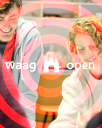Without a doubt, our lives are becoming increasingly dependent on new technologies. However, we are also becoming increasingly aware that not everyone benefits equally from the opportunities and possibilities of digitization. Technology is often developed for the masses, leaving more vulnerable groups behind. Through the European-funded CommuniCity project, the municipality of Amsterdam aims to support the development of digital solutions for all by connecting tech organisations to the needs of vulnerable communities. The project will develop a citizen-centred co-creation and co-learning process supporting the cities of Amsterdam, Helsinki, and Porto in launching 100 tech pilots addressing the needs of their communities.
Besides the open call for tech-for-good pilots, the municipality of Amsterdam is also looking for a more structural process for matching the needs of citizens to solutions of tech providers. During this work session, Neeltje Pavicic (municipality of Amsterdam) invited the Amsterdam Smart City network to explore current bottlenecks and potential solutions and next steps.
Process & questions
Neeltje introduced the project using two examples of technology developed specifically for marginalised communities: the Be My Eyes app connects people needing sighted support with volunteers giving virtual assistance through a live video call, and the FLOo Robot supports parents with mild intellectual disabilities by stimulating the interaction between parents and the child.
The diversity of the Amsterdam Smart City network was reflected in the CommuniCity worksession, with participants from governments, businesses and knowledge institutions. Neeltje was curious to the perspectives of the public and private sector, which is why the group was separated based on this criteria. First, the participants identified the bottlenecks: what problems do we face when developing tech solutions for and with marginalised communities? After that, we looked at the potential solutions and the next steps.
Bottlenecks for developing tech for vulnerable communities
The group with companies agreed that technology itself can do a lot, but that it is often difficult to know what is already developed in terms of tech-for-good. Going from a pilot or concept to a concrete realization is often difficult due to the stakeholder landscape and siloed institutions. One of the main bottlenecks is that there is no clear incentive for commercial parties to focus on vulnerable groups. Another bottleneck is that we need to focus on awareness; technology often targets the masses and not marginalized groups who need to be better involved in the design of solutions.
In the group with public organisations, participants discussed that the needs of marginalised communities should be very clear. We should stay away from formulating these needs for people. Therefore, it’s important that civic society organisations identify issues and needs with the target groups, and collaborate with tech-parties that can deliver solutions. Another bottleneck is that there is not enough capital from public partners. There are already many pilots, but scaling up is often difficult.. Therefore solutions should have a business, or a value-case.
Potential next steps
What could be the next steps? The participants indicated that there are already a lot of tech-driven projects and initiatives developed to support vulnerable groups. A key challenge is that these initiatives are fragmented and remain small-scale because there is insufficient sharing and learning between them. A better overview of what is already happening is needed to avoid re-inviting the wheel. There are already several platforms to share these types of initiatives but they do not seem to meet the needs in terms of making visible tested solutions with most potential for upscaling. Participants also suggested hosting knowledge sessions to present examples and lessons-learned from tech-for-good solutions, and train developers to make technology accessible from the start. Legislation can also play a role: by law, technology must meet accessibility requirements and such laws can be extended to protect vulnerable groups. Participants agreed that public authorities and commercial parties should engage in more conversation about this topic.
In response to the worksession, Neeltje mentioned that she gained interesting insights from different angles. She was happy that so many participants showed interest in this topic and decided to join the session. In the coming weeks, Neeltje will organise a few follow-up sessions with different stakeholders. Do you have any input for her? You can contact me via sophie@amsterdamsmartcity.com, and I'll connect you to Neeltje.





